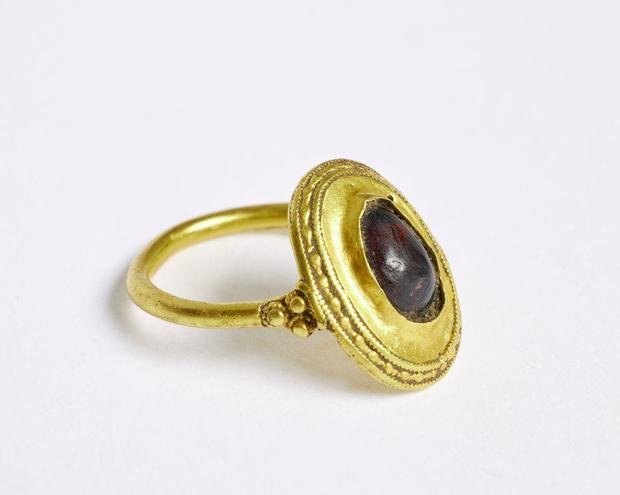Metal detectorist finds 1,400-year-old gold ring likely owned by royal family: "Surreal"
A man in Denmark made a stunning discovery while out with his metal detector in a small hamlet near the country's southwestern border with Germany. Buried in dirt was a striking gold ring, set with a red semi-precious stone, which may shed new light on Danish history dating back more than 1,400 years.
Officials at the National Museum of Denmark recently announced the find after the centuries-old ring came into its own custody, following a transfer from a different museum near the discovery site.
The rare piece of jewelry, which likely was created around the 5th or 6th century, holds special significance for Danish historians and archaeologists, museum officials said in their announcement this week. That's because because the ring itself, and the spot where it was found, suggests that an elite group had settled in that area — Emmerlev, at Denmark's southern peninsula — which was not previously known before.
Lars Nielson, the 39-year-old metal detectorist who discovered the ring, said that finding the ring was "surreal."

"I was so excited and overwhelmed that I could hardly say anything, and that's not usually something that characterizes me, but it is without a doubt my best find so far. To make such a unique and one-of-a-kind find is completely surreal. I am very proud and honored to be able to contribute a piece to our shared history both locally and nationally," Nielson said.
The ring's origins and to whom it initially belonged is also a particular point of interest, even though the owners in Denmark are still a mystery. But the ring's construction suggests that the owners were connected to the Merovingians, a royal dynasty that ruled the Franks, or the Kingdom of France, between the 5th century and the middle of the 7th century. As the museum notes, the kingdom at that time encompassed large parts of modern-day Europe, including much of Belgium, France and Germany.
Kirstine Pommergaard, an inspector at the National Museum of Denmark who studied the ring, said that details about the piece are similar to other rings known to have been worn by Merovingian elite.
"The gold ring not only reveals a possible new princely family in Emmerlev, but also connects the area with one of Europe's largest centers of power in the Iron Age," Pommergaard said in a translated statement to the museum. "The gold ring is probably a woman's ring and may have belonged to a prince's daughter who was married to a prince in Emmerlev."
Pommergaard went on to note that gold typically signified "diplomatic gifts" and in some cases were used to mark unions where people "married into alliances." Certain details of this ring, like the spiral designs on its underside and trefoil markings between the band and the stone, are characteristic of Frankish creations.

"It is an impressive level of craftsmanship that is difficult to imitate today," said Pommergaard.
Archaeologists do not believe that the ring ended up in Emmerlev by chance, since other objects, including two gold coins, seven silver coins and Frisian pottery, have been found in the same area. That reinforces the idea that settlers in Emmerlev had contact with Merovingians, potentially via Friesland, which was spread across what is now Belgium and the Netherlands, the museum said.
And, the fact that the ring is set with a semi-precious stone — a symbol of Nordic influence — instead of a coin or plaque — a symbol of Merovingian elitism — suggests this piece was meant to be a display of power in the Nordic region specifically. It was found just about 6 miles from a set of previously unearthed golden horns that officials believe date back to the 4th century, and just over a mile from a fortress dating back to the first century.
Experts said that all of this together has raised the possibility that the southern Danish peninsula was once home to enduring local powers that are in large part still a mystery.
- In:
- Denmark
Emily Mae Czachor is a reporter and news editor at CBSNews.com. She covers breaking news, often focusing on crime and extreme weather. Emily Mae has previously written for outlets including the Los Angeles Times, BuzzFeed and Newsweek.
Twitter InstagramDisclaimer: The copyright of this article belongs to the original author. Reposting this article is solely for the purpose of information dissemination and does not constitute any investment advice. If there is any infringement, please contact us immediately. We will make corrections or deletions as necessary. Thank you.
Title:Metal detectorist finds 1,400-year-old gold ring likely owned by royal family: "Surreal"
Url:https://www.investsfocus.com







